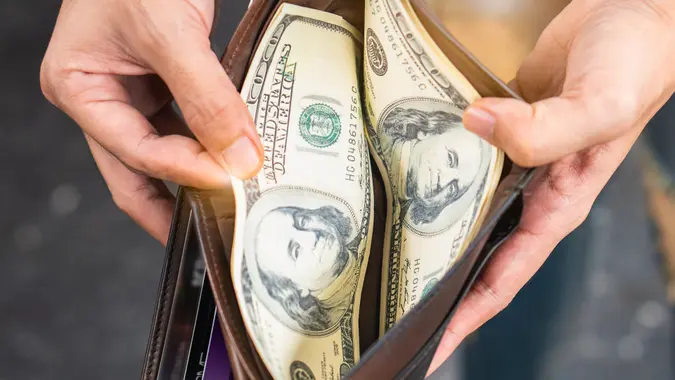10 Biweekly Money-Saving Challenges To Try in 2025

Commitment to Our Readers
GOBankingRates' editorial team is committed to bringing you unbiased reviews and information. We use data-driven methodologies to evaluate financial products and services - our reviews and ratings are not influenced by advertisers. You can read more about our editorial guidelines and our products and services review methodology.

20 Years
Helping You Live Richer

Reviewed
by Experts

Trusted by
Millions of Readers
Savings challenges are often designed around pay cycles, so a biweekly money-saving challenge requires you to put money away every two weeks — or for your next 26 paychecks. Here are some biweekly challenges for anyone who can’t seem to save or successful savers who want to boost their savings.
1. 26-Week Biweekly Challenge
With this savings challenge, you increase how much you save every two weeks by a set amount.
For example, start by saving $4 in the first pay period, then add $4 more each time — $8 in the second period, $12 in the third and so on. By the 26th paycheck, you’ll save $104 and end the year with a total of $1,404.
You can adjust the starting amount to fit your budget. Starting at $3 and adding $3 each time, you would save $1,053 in a year. Want a bigger challenge? Try $5 increments to reach $1,755 in one year.
2. 52-Week Biweekly Challenge
You can adapt the classic 52-week savings challenge to a biweekly schedule by saving every other week instead of weekly.
One approach: start with $10, then increase by $2 each pay period to keep the momentum without the weekly commitment.
3. Reverse 52-Week Biweekly Challenge
To follow a biweekly version of the reverse challenge, save the highest amounts earlier in the year, with a steady decrease every two weeks.
For example, start with $100, then drop by $4 per pay period until you reach your lowest deposit.
Saving larger amounts could be easier at the beginning when you are most excited and motivated to do the challenge.
4. $20 Money-Saving Challenge
The $20 money-saving challenge is when savers schedule an automatic transfer for a set amount from checking into savings each pay period and complete the challenge without further effort.
If you do this on a biweekly schedule, you can save upwards of $1,040 in 12 months.
How Much You Can Save With $20 or More
Setting aside $20 every two weeks adds up fast — and increasing that amount even slightly can make a big difference. Here’s what you could save in one year with consistent biweekly deposits:
Amount Saved Biweekly Total Saved in 12 Months $10 $260 $20 $520 $30 $780 $40 $1,040 $50 $1,300
5. $2,025 in 2025 Challenge
If you prefer a little less structure, this challenge is for you, as the saving amounts can fluctuate. If you have a week that’s hard on your budget, you can save a little less and make it up the next week without feeling like you’re missing your goal.
For the biweekly version of this challenge, you would have to save at least $77.88 every two weeks. When broken down like that, it seems very doable.
6. Biweekly No Spend Challenge
In a classic no-spend challenge, you would avoid all nonessential purchases for an entire month. To make it more biweekly friendly, try alternating spending and no-spending weeks.
For example, only buy essentials in one pay period and then allow limited discretionary spending the next. This on-off cycle helps you reset habits and build awareness of where your money’s going.
Just be sure to move what you didn’t spend into savings at the end of your no-spend week — that’s how you make the challenge count.
7. Biweekly 100 Envelope Challenge
Want to take on the 100 envelope challenge — but at a biweekly pace? Here’s how to make it work:
- Get 100 empty envelopes and number them from one to 100.
- Every two weeks — or on payday — pick two envelopes at random.
- Add the dollar amount written on each envelope. For example, envelope No. 17 and No. 45 mean you’ll save $62 that pay period.
- Put the filled envelopes aside and track your progress.
- Continue this process for 50 pay periods to complete the challenge.
Complete all 100 envelopes and you’ll have saved $5,050 — whether it takes 100 days or 100 weeks depends on your pace, but the payoff stays the same.
Don’t want to use envelopes? You can use this printable tracker to track your savings.
8. Trim 1% of Your Salary Challenge
If you get paid biweekly, this challenge is easy to work into your budget.
For example, if you earn $1,500 every two weeks, you would set aside and save $15 every paycheck. It’s a simple, low-pressure way to build your emergency fund and get into the habit of saving regularly.
9. Bowl Grab Challenge
Keep a big bowl in a common area of your house. Write down varying amounts of money, such as $5, $20 and $50, on slips of paper and place the slips in the bowl. Make it a biweekly tradition by grabbing a slip every payday and saving the amount listed.
This challenge is an easy, fun and effective way to save money for the whole family.
10. Holiday Fund Challenge
If you find yourself going into debt every holiday season, a holiday fund challenge could be the answer to staying debt-free.
Make a list of all of your expenses for the holidays and add them up. Then divide that total by the number of biweekly pay periods left in the year.
For example, if you have 24 total weeks remaining this year, that gives you 12 biweekly pay periods. If your holiday budget is $1,200, that means you’ll need to save $100 every other week.
Rules and Tips for a Successful Biweekly Challenge
- Know your “why”: A clear goal can keep you focused when motivation slips.
- Open a separate savings account: Keeping your savings out of sight helps prevent spending it.
- Track your progress: Use a spreadsheet or templated form to stay on track.
- Celebrate milestones: Set small rewards along the way to keep momentum going.
Bonus: Other Savings Challenges To Consider
If a biweekly money-saving challenge doesn’t fit your income and budget, there are plenty of other savings options. Here are some other popular alternatives to help you reach your savings goals:
- The pantry challenge: Skip grocery shopping and use only what you already have at home.
- Change your grocery store challenge: Shop at a lower-cost store for a month to cut food expenses.
- No eating out for a month challenge: Prep all meals at home to eliminate restaurant spending.
- The $5 trick: Save every $5 bill you receive to build your savings without noticing.
If you open a savings account at a financial institution separate from your regular bank, it can lessen the temptation of dipping into your savings when managing everyday spending.
Final Take: Build a Biweekly Savings Plan That Works for You
Making a game out of intentionally saving money challenges non-savers to build money-saving habits that can last a lifetime. A savings challenge should be difficult, but not so demanding that challengers can’t do it. Pick a biweekly money-saving challenge that works for your budget and saving style.
Biweekly Savings Challenges: FAQ
Got questions? Here are quick answers to help you stay on track and make the most of your savings routine.- How can I save money every two weeks?
- The simplest way to save money every two weeks is to set a biweekly automatic transfer from checking into savings. Pick an amount that won't cause any overdrafts.
- To save more, you can gradually increase the transfer amount, especially after pay increases or as debts are paid off.
- How much should I save if I get paid biweekly?
- The amount you should save biweekly depends on your savings goal. If you want to save $3,000, divide that amount by 26 weeks. This means you should save at least $115.38 each time you get paid.
- What is a biweekly savings challenge?
- A biweekly savings challenge means you set aside money from your paycheck every other week.
- The 26-week savings challenge is a great place to start. With this challenge, you increase your savings by a set increment – like $4, for example – from each paycheck. If you add $4 each pay period, you save $8 from the second paycheck, $12 from the third and so on.
- With $4 increments, you would save $1,404 over one year.
- What is the 52-week money-saving challenge?
- Starting a 52-week savings challenge begins with saving $1 in your first week.
- Each week for a year, you'll increase the amount of money you save each week by $1. The second week, you'll save $2, then $3 the third week and so on, until you save $52 in the final week.
- Your total savings with this challenge amounts to $1,378 if you're dedicated.
- What is the $20 savings challenge?
- The $20 savings challenge is a 52-week challenge during which a challenger saves $20 per week for 52 weeks. At the challenge's completion, you'll have saved $1,040.
- If $20 every week doesn't work for you, you can adjust this challenge to save $20 biweekly or pick a different amount.
- What's the best way to save $10,000 biweekly?
- Divide $10,000 by 26 weeks and you'll get $384.62. Save at least that much every two weeks to hit a $10,000 savings goal within one year.
- If you want to take two years to save $10,000, divide $384.62 in half, and save at least that amount every two weeks.
- Can the 100 envelope challenge be done biweekly?
- Yes, the 100 envelope challenge can be done biweekly and might be the most practical way if that matches your pay cycle.
- If you follow the standard method of one envelope per payday, it will take about four years to complete.
- You can cut that time in half by filling two envelopes. Or, try pulling one high number and one low number to keep it manageable.
Andrea Norris and Cynthia Measom contributed to the reporting for this article.
Our in-house research team and on-site financial experts work together to create content that’s accurate, impartial, and up to date. We fact-check every single statistic, quote and fact using trusted primary resources to make sure the information we provide is correct. You can learn more about GOBankingRates’ processes and standards in our editorial policy.
- Rocket Money. 2024. "How To Do A Biweekly Money-Saving Challenge."
- Educounting. "The Bi-Weekly Money Saving Challenge: A Fun Way to Boost Your Budget."
 Written by
Written by  Edited by
Edited by 
























